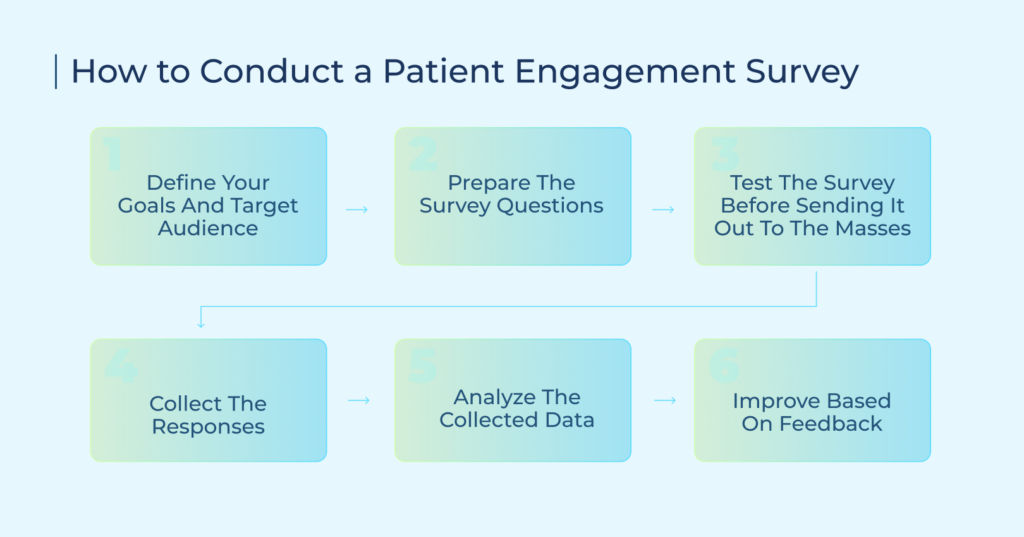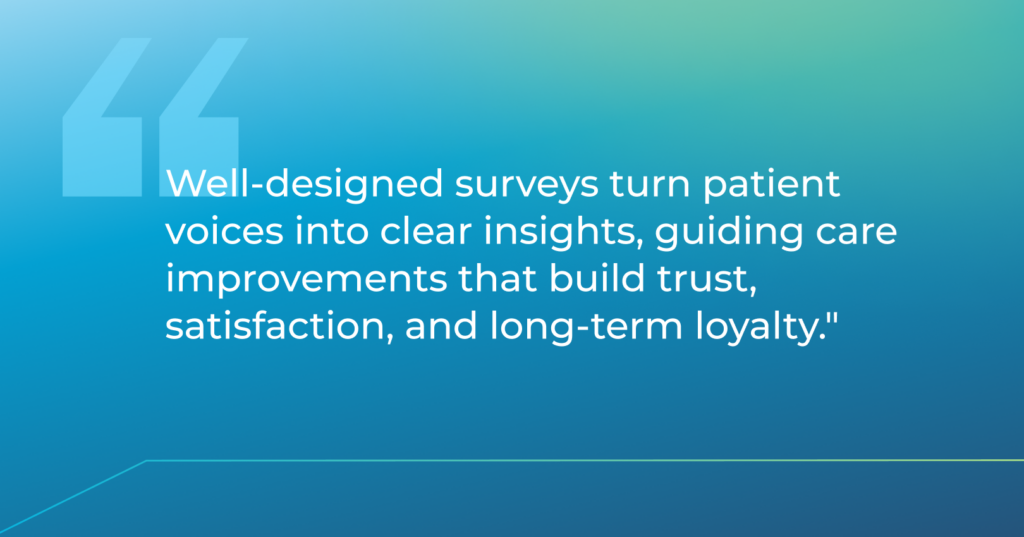Televox is proud to announce that its Enterprise Edition SMS solution has been awarded Gold…

How to Conduct Patient Engagement Surveys for Valuable Insights
Conducting surveys is not uncommon for healthcare providers, but many of them do struggle to turn their data into actionable improvements. The main issues often lie in how these surveys are done. Pushing generic and unoptimized questionnaires will always fail to capture the most valuable insights. A survey that hits its mark with accuracy enables providers to improve their overall care quality and patient satisfaction scores. This guide walks you through the key steps to conducting effective patient engagement surveys that lead to measurable improvements.
What’s a Patient Engagement Survey?
Healthcare providers are strongly encouraged to involve patients in their own healthcare for better outcomes. Patient engagement surveys measure exactly that, the willingness to be active participants in discussing treatment options, following treatment plans, and using health resources to improve self-care.
However, for patients to be listening and asking questions requires them to have an excellent patient experience. This is a different metric from patient engagement.
Instead of measuring how much effort patients make to improve their healthcare, patient experience surveys measure the quality of care received. They provide insights into what patients feel about their healthcare journey. This starts from the first interaction of scheduling an appointment to the last touchpoint of post-visit care follow-up.
Hence, two patients can receive the same care, but their satisfaction might differ. So, only one of them might actively engage.
Why Are Patient Engagement Surveys Important?
Data extracted from patient engagement surveys helps healthcare providers improve their services, leading to various benefits for both patients and care providers. These surveys bring to light why and how providers are falling short in their engagement strategies.
The results? Patients gain a better understanding of their conditions and feel more confident in managing their health, while providers reap improved patient loyalties.
How to Conduct a Patient Engagement Survey
There’s a lot more to conducting patient engagement surveys than just making questionnaires at random. Well-researched survey questions generate valuable insights that lead to better care. They also make patients feel valued. Here’s how a well-designed survey process works for improving patient engagement:

Step 1: Define Your Goals and Target Audience
The first step is determining what exactly you want to measure. Saying you want to improve overall patient experience or satisfaction is too broad a spectrum. Focus on specific aspects like appointment scheduling, wait times, communication, services, etc.
Then identify the kind of patients who you want to take the survey. For instance, patients who recently had a medical procedure done or visited the care provider in the last two weeks.
For department-specific questions, choose patients who have actually interacted with the department in question. Remember, you can only collect the right data from the right people.
Step 2: Prepare the Survey Questions
You can now start creating your patient engagement survey questions. Make sure that each question is easy to understand and answer. Pushing overly complex questionnaires means unreliability and fewer people willing to spend time on each question.
Additionally, limit your survey to 10-15 questions to prevent fatigue. For actionable insights, it is always better to focus on experiences rather than impressions. Hence, asking about the ease of scheduling an appointment is better than asking whether the patient felt the scheduling process was good or bad.
Step 3: Test the Survey Before Sending It Out to the Masses
Run a small pilot test to ensure your patient engagement survey checks all the boxes of your initial goals from the first step. Sending the survey to a few people, even staff members, can also point out technical issues, ambiguities, etc. Use their feedback to make adjustments as needed before sending out the final questionnaire to the masses.
Step 4: Collect the Responses
Surveys depend on participants, and to reach out to the most patients, make sure to distribute your engagement survey through multiple channels.
This includes sharing survey links through text messages, sending out email campaigns, pushing notifications to patient portals, integrating QR codes in waiting rooms for direct feedback, in-person physical handouts, etc.
Step 5: Analyze the Collected Data
Now for the hard part: sorting through stacks of survey data and finding patterns, trends, main points, and areas to improve.
Be on the lookout for questions with unusually high or low scores, changes in the data since the previous survey, the most frequent complaints in written feedback, etc.
This can be an intimidating task, given the number of participants. Therefore, healthcare professionals can be clever about it by employing AI-based systems to scan the data gathered on their behalf.
Step 6: Improve Based on Feedback
Finally, turn your survey insights into actions. Make immediate changes to address simple issues and long-term plans to bridge complex service gaps such as by setting KPIs. Healthcare providers can also use this opportunity to show patients their input is valued by informing them of what changes are being made based on their given feedback.
Example Questions for Your Patient Engagement Questionaire
Here are 10 clear, focused questions you can include in your patient engagement survey. These questions target key areas of the patient experience while remaining specific and actionable.
They also avoid general satisfaction in favor of specific experiences that you can directly address. The mix of multiple-choice and open-ended questions provides both quantifiable data and detailed feedback.
Q1: “How many days did you wait between scheduling your appointment and your actual visit?”
- Less than 7 days
- 7-14 days
- 15-30 days
- More than 30 days
Q2: “How would you rate the ease of scheduling your appointment?”
- Very difficult
- Somewhat difficult
- Somewhat easy
- Very easy
Q3: “How long did you wait in the reception area beyond your scheduled appointment time?”
- 0-15 minutes
- 16-30 minutes
- 31-60 minutes
- More than 60 minutes
Q4: “Did you find the facility clean and comfortable?”
- Yes
- Somewhat
- No
Q5: “Did your doctor listen carefully to your concerns?”
- Yes, completely
- Yes, somewhat
- No
Q6: “Did you understand the explanations about your health condition or treatment?”
- Yes, completely
- Yes, somewhat
- No
- I didn’t receive explanations
Q7: “Were you involved in decisions about your care as much as you wanted?”
- Yes
- Somewhat
- No
Q8: “Were your test results explained clearly?”
- Yes
- Somewhat
- No
Q9: “What did we do well during your visit?”
>Open text response
Q10: “What specific change would most improve your experience with us?”
>Open text response
Benefits of Conducting Patient Engagement Surveys
- Better Health Outcomes: Patients cannot be forced to cooperate, but can be convinced to prioritize their health. Providing tailored and personalized treatments leads to improved patient experiences, which further leads to happy patients who will follow their treatment plans and return for future care.
- Increased Patient Retention: Satisfied (and happy) patients are more likely to return for future care. They are also likely to recommend your facility to their friends and family, creating an ever-growing web of loyal patients and reduced churn rates.
- Operational Efficiency: It’s not just about the patients. Healthcare providers gain valuable data through patient-led surveys on how their healthcare teams are performing. This can help identify service gaps and inefficient workflows.
- Improved Resource Allocations: Identifying areas of improvements through patient engagement surveys also means that healthcare faclities get to allocate their resources better. This is efficient and better for long-term impacts instead of just splitting monthly budgets between departments.
How TeleVox Helps in Improving Patient Engagement
Let TeleVox’s SMART Agent take charge of your administrative burdens. Our conversational AI virtual agents automate both routine and tedious tasks to proactively engage patients at every touchpoint of their journey.
From scheduling appointments to answering EHR inquiries, this self-service solution not only streamlines workflows but also ensures that patients receive timely, accurate information without long wait times.
The results? Happier patients and better health outcomes.

Televox brings next-generation AI to healthcare. Schedule a demo today and discover how our HIPAA-compliant platform can improve your patient engagement and experiences.



